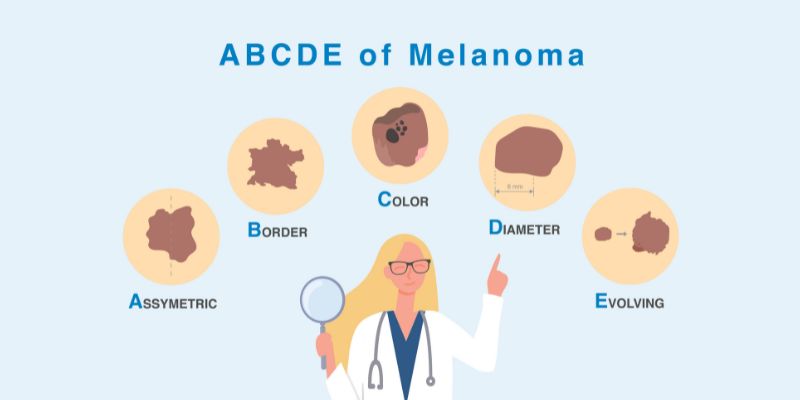Melanoma Awareness Month: Know Your Risk
May is Melanoma and Skin Cancer Awareness Month. According to the American Cancer Society, skin cancer is the most common form of cancer. Although melanoma accounts for just 1% of those cancers, it is considered the most dangerous form of skin cancer. Melanoma can be deadly if not caught and treated early on, as it is more likely to grow and spread to other parts of the body. Overlake dermatologist Margaret Mioduszewski, MD, shares how to protect yourself and loved ones by knowing melanoma's signs, symptoms and risk factors.
What are the signs and symptoms of melanoma?
Regular skin self-exams may help detect skin cancer early—when it’s smaller and easier to treat. Become familiar with the way your skin and moles look. The first symptom of melanoma is often a change in a mole or the appearance of a new mole. The ABCDE rule can help you tell a normal mole from one that might be cancerous:

- A - Asymmetry. One half of the mole does not look like the other half.
- B - Border irregularity. The edges of the mole are ragged or irregular.
- C - Color. The mole has different colors within it. It may be tan, brown, black, red or other colors. Or it may have areas that appear to have lost color.
- D - Diameter. The mole is bigger than 6 mm or ¼ inch across, about the size of a pencil eraser. But some melanomas can be smaller.
- E - Evolving. A mole changes in size, shape or color. This can happen quickly or slowly.
Self-Exam Tip: Don't overlook your nails when checking your body for signs of skin cancer. The American Academy of Dermatology (AAD) points out that skin melanoma can develop within and under the fingernails and toenails. Though rare, it's more common in older people with darker skin.
Who is at risk for melanoma?
The most common risk factors for melanoma include:
- Age. Melanoma is more common in older people, but it is still one of the more common cancers in people younger than age 30, especially younger women.
- Gender. Men have a higher risk for melanoma overall, but women have a higher risk before age 50.
- Sun exposure. Sunlight, the primary source of ultraviolet (UV) light rays, is a major risk factor for melanomas (and other skin cancers). Research suggests that experiencing several and severe sunburns, especially in childhood, increases the risk of developing melanoma.
- Tanning beds. Tanning beds emit UV rays. The use of tanning beds and sunlamps has been linked to an increased risk of melanoma.
- Moles. While most moles are harmless, people who have many moles or abnormal-appearing moles (dysplastic nevi) are at increased risk for melanoma.
- Fair skin, light hair. People with light-colored skin are many times more likely to develop melanoma than those with darker skin. People with very pale skin, those who freckle easily, those with red or blond hair, or those with blue or green eyes are at higher risk.
- Family history. People whose parents or siblings have had melanoma are at higher risk of melanoma. In some families, people share specific gene mutations that increase their risk.
- Certain inherited conditions. People with certain rare, inherited conditions, such as xeroderma pigmentosum (XP), are at increased risk for melanoma.
- Personal history of skin cancer. People who have had melanoma or another type of skin cancer in the past are more likely to develop melanoma again.
- Weak immune system. People with a weak immune system, such as those who have had an organ transplant, undergone chemotherapy or those infected with the HIV virus, are at higher risk for melanoma.
If you have any additional questions, want to learn how to reduce your risk further, or are concerned about a changing or growing skin lesion, please make an appointment with a dermatologist for a full assessment and evaluation. Learn more at overlakehospital.org/services/dermatology.









